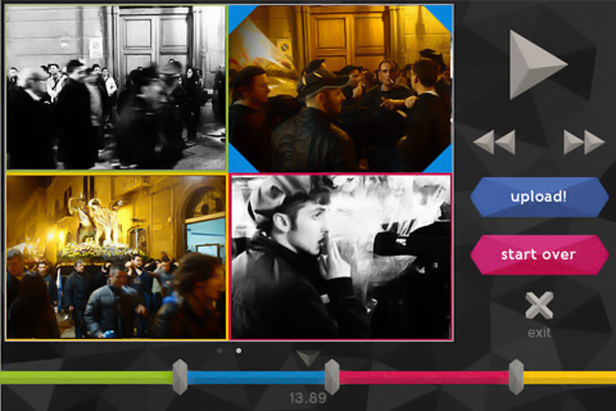Using Your Smart Phone to Mix Video Clips with Others

Taking a video of a concert or ball game with your smart phone and uploading it to YouTube is easy. Finding other videos taken by fellow spectators at the same time and stitching them into one seamless recording is a lot harder.
A new app called Vyclone promises to do that hard stuff for you. Created by Joe Sumner and David King Lassman, the app can be used for all kinds of things, from concert and wedding recordings to short films and citizen journalism projects. Sumner and King Lassman say they aren’t trying to compete with professional video-editing tools—rather, they see Vyclone as something anyone can use on the fly. “We can all have our Scorsese moment, irrespective of experience and ability,” King Lassman says.
As more people tote smart phones everywhere they go, Vyclone and a growing number of other mobile apps are trying to bring functionality to smart phones that until recently was restricted to computers.
Sumner, a singer-songwriter, thought of the idea in 2010 while touring as a member of the band Fiction Plane. He noticed that audience members spent much of the show recording it with their cell phones and then posted their videos on YouTube. Sumner figured there must be a simple way to link all the phones at an event and create an automatically generated compilation of the different videos taken simultaneously. That way “people would be able to look at every single viewpoint and see everything,” he says.
Sumner began working with King Lassman, a technology entrepreneur, on software that could rapidly analyze, process, mash up, and spit out video recorded by people at the same event. In May they rolled out the free iPhone app in their native England, which they’re treating as a test market before bringing the app stateside this summer.
When two or more people record the same scene simultaneously and upload those clips using Vyclone, software determines when the videos were shot, uses GPS to determine that they were taken in the same place, and automatically assembles suitable clips into one combined video in which the audio is constant but the camera angles change.
The app is easy to use, though the version I tried still had kinks. Most noticeable was a lack of speed: there were often several-second delays when I started recording, and playback sputtered. But the videos were impressive, with decent cuts and flawless sound.
To record a video, you tap the app’s red on-screen camera button; this brings up the recording window, along with a short list of filters you can use to change the look of your creation. You can record for up to 60 seconds, and a little on-screen notification will let you know how many other people are recording in the vicinity at the same time (the software can mash up clips from as many as four people).
Once you’re done shooting a video, you can upload your clip or save it for later uploading. (The version of the app that I used gave me no way to go back and delete videos after uploading them; King Lassman says a newer version does include one.)
After using Vyclone a couple times, I got the sense that it was somehow cutting my videos with a director’s eye, as it seemed to switch from one camera view to another at opportune times. But King Lassman says that although Vyclone is developing smarter algorithms, the technology in use right now is “pretty crude.”
If you aren’t satisfied with Vyclone’s cut—perhaps you were shouting directions at your break-dancing colleague, for example—you can instruct the app to generate another version or create your own remix with simple on-screen editing tools.
Like the many social video apps that came before it, Vyclone includes tabs that let you check out new and popular videos from other users, videos shot nearby, videos you’ve taken and edited, and more. Users can also remix videos posted by others and see a map view of where videos have been shot.
In the future, Sumner says, you may be able to choose a clip from your phone’s camera roll, have Vyclone match it up with a related clip shot by someone else, and put the two together. Vyclone is also working on a feature that lets users mash up their videos with others by only specific people. Eventually, the company may charge for certain features, King Lassman says.
If Vyclone gains a lot of users, it may incorporate the ability to check in to events, in order to determine more accurately that people are filming the same subject. “We want to make it as accessible, as immediate, as simple as possible to use,” King Lassman says.
Keep Reading
Most Popular
Large language models can do jaw-dropping things. But nobody knows exactly why.
And that's a problem. Figuring it out is one of the biggest scientific puzzles of our time and a crucial step towards controlling more powerful future models.
The problem with plug-in hybrids? Their drivers.
Plug-in hybrids are often sold as a transition to EVs, but new data from Europe shows we’re still underestimating the emissions they produce.
Google DeepMind’s new generative model makes Super Mario–like games from scratch
Genie learns how to control games by watching hours and hours of video. It could help train next-gen robots too.
How scientists traced a mysterious covid case back to six toilets
When wastewater surveillance turns into a hunt for a single infected individual, the ethics get tricky.
Stay connected
Get the latest updates from
MIT Technology Review
Discover special offers, top stories, upcoming events, and more.